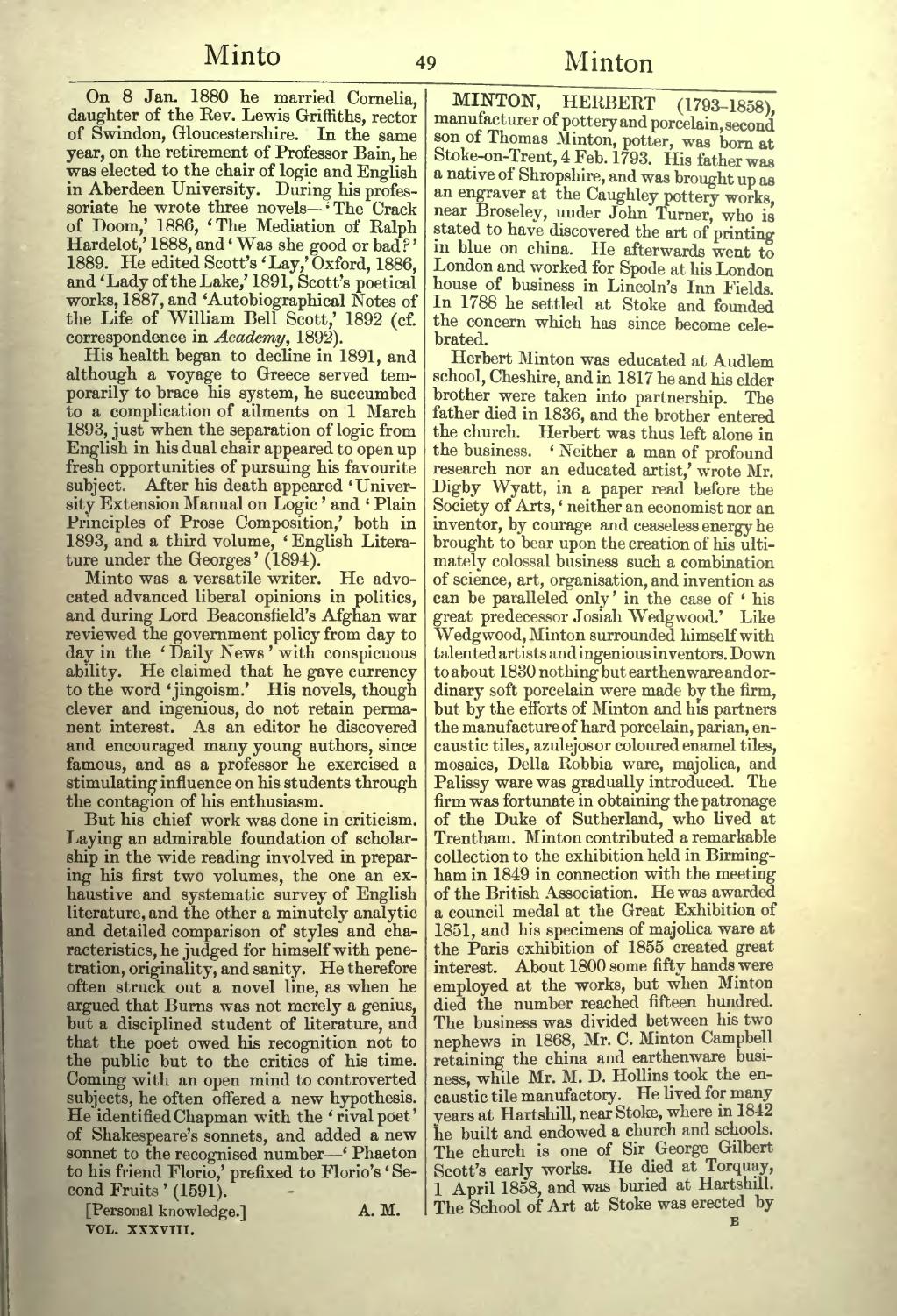On 8 Jan. 1880 he married Cornelia, daughter of the Rev. Lewis Griffiths, rector of Swindon, Gloucestershire. In the same year, on the retirement of Professor Bain, he was elected to the chair of logic and English in Aberdeen University. During his professoriate he wrote three novels—‘The Crack of Doom,’ 1886, ‘The Mediation of Ralph Hardelot,’ 1888, and ‘Was she good or bad?’ 1889. He edited Scott's ‘Lay,’ Oxford, 1886, and ‘Lady of the Lake,’ 1891, Scott's poetical works, 1887, and ‘Autobiographical Notes of the Life of William Bell Scott,’ 1892 (cf. correspondence in Academy, 1892).
His health began to decline in 1891, and although a voyage to Greece served temporarily to brace his system, he succumbed to a complication of ailments on 1 March 1893, just when the separation of logic from English in his dual chair appeared to open up fresh opportunities of pursuing his favourite subject. After his death appeared ‘University Extension Manual on Logic’ and ‘Plain Principles of Prose Composition,’ both in 1893, and a third volume, ‘English Literature under the Georges’ (1894).
Minto was a versatile writer. He advocated advanced liberal opinions in politics, and during Lord Beaconsfield's Afghan war reviewed the government policy from day to day in the ‘Daily News’ with conspicuous ability. He claimed that he gave currency to the word ‘jingoism.’ His novels, though clever and ingenious, do not retain permanent interest. As an editor he discovered and encouraged many young authors, since famous, and as a professor he exercised a stimulating influence on his students through the contagion of his enthusiasm.
But his chief work was done in criticism. Laying an admirable foundation of scholarship in the wide reading involved in preparing his first two volumes, the one an exhaustive and systematic survey of English literature, and the other a minutely analytic and detailed comparison of styles and characteristics, he judged for himself with penetration, originality, and sanity. He therefore often struck out a novel line, as when he argued that Burns was not merely a genius, but a disciplined student of literature, and that the poet owed his recognition not to the public but to the critics of his time. Coming with an open mind to controverted subjects, he often offered a new hypothesis. He identified Chapman with the ‘rival poet’ of Shakespeare's sonnets, and added a new sonnet to the recognised number—‘Phæton to his friend Florio,’ prefixed to Florio's ‘Second Fruits’ (1591).
[Personal knowledge.]
MINTON, HERBERT (1793–1858), manufacturer of pottery and porcelain, second son of Thomas Minton, potter, was born at Stoke-on-Trent, 4 Feb. 1793. His father was a native of Shropshire, and was brought up as an engraver at the Caughley pottery works, near Broseley, under John Turner, who is stated to have discovered the art of printing in blue on china. He afterwards went to London and worked for Spode at his London house of business in Lincoln's Inn Fields. In 1788 he settled at Stoke and founded the concern which has since become celebrated.
Herbert Minton was educated at Audlem school, Cheshire, and in 1817 he and his elder brother were taken into partnership. The father died in 1836, and the brother entered the church. Herbert was thus left alone in the business. ‘Neither a man of profound research nor an educated artist,’ wrote Mr. Digby Wyatt, in a paper read before the Society of Arts, ‘neither an economist nor an inventor, by courage and ceaseless energy he brought to bear upon the creation of his ultimately colossal business such a combination of science, art, organisation, and invention as can be paralleled only’ in the case of ‘his great predecessor Josiah Wedgwood.’ Like Wedgwood, Minton surrounded himself with talented artists and ingenious inventors. Down to about 1830 nothing but earthenware and ordinary soft porcelain were made by the firm, but by the efforts of Minton and his partners the manufacture of hard porcelain, parian, encaustic tiles, azulejosor coloured enamel tiles, mosaics, Della Robbia ware, majolica, and Palissy ware was gradually introduced. The firm was fortunate in obtaining the patronage of the Duke of Sutherland, who lived at Trentham. Minton contributed a remarkable collection to the exhibition held in Birmingham in 1849 in connection with the meeting of the British Association. He was awarded a council medal at the Great Exhibition of 1851, and his specimens of majolica ware at the Paris exhibition of 1855 created great interest. About 1800 some fifty hands were employed at the works, but when Minton died the number reached fifteen hundred. The business was divided between his two nephews in 1868, Mr. C. Minton Campbell retaining the china and earthenware business, while Mr. M. D. Hollins took the encaustic tile manufactory. He lived for many years at Hartshill, near Stoke, where in 1842 he built and endowed a church and schools. The church is one of Sir George Gilbert Scott's early works. He died at Torquay, 1 April 1858, and was buried at Hartshill. The School of Art at Stoke was erected by
